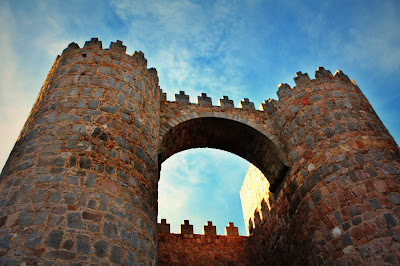Welcome to "la tierra de cantos y santos", the land of Stones and Saints. This is Ávila, the capital of Castilla y León - a medieval city with a well preserved fortified wall which earned it a place on UNESCO's list of World Heritage Sites.

Above: Las Murallas - The Walls of Ávila

Above: Las Murallas - The Walls of Ávila
Taking a step back (as if I could really take in ALL of it), I continued to stare in awe. This is not a fake fortress taken off a Disney set. It's real, solid and complete - all 2.5km of it. First built as a defence against the Moors in the late 11th Century, part of the wall today is open for a walk-up for visitors.
Some quick facts about the wall:
- Building blocks are reused from old Roman buildings, even from tomb stones
- Wall measures approx. 2.5km in total length
- Has an avg. height of 12m
- Thickness of 3m
- Consists of 88 towers
- Has 2,500 embattlements
- Has 9 gates

Above: An aerial satellite view of the astounding medieval wall encircling the old town, taken from GoogleMap. What's amazing is how complete the wall is and how it's kept in such great condition.

Above: Ayuntamiento

In the heart of the enclosure within the City Walls you can find the Ayuntamiento (Town Hall), located at Plaza de la Victoria. Arcades of bars and restaurants surround the Plaza. Ávila's main shopping streets can also be found around this square.

Above: The Cathedral of Ávila. Flushed against the east side of the Wall, the robust & fortress-like Cathedral actually forms part of it.
First constructed in the 11th Century, changes were later made to the Cathedral between the 12th - 14th Centuries. Today, the Cathedral is seen to have a mix of Romanesque & Gothic style of architecture.




Above: Inside the Cathedral.

Above: Discovered during recent excavations, this is one of the ancient Celtiberian granite sculptures known as ‘verracos’ - they can represent bulls, pigs or bears. This one though, I believe, is a pig, defaced by the elements over time. History has it that they existed since the 2nd Century BC when Celtic people occupied the area.


Above: The Puerta del Alcázar (Alcazar Gate) - one of the most travelled and oldest of the 9 entrances into the enclosed city.


Above: Outside the wall, next to the Puerta del Alcázar is a white stone carving of St. Teresa, the female patron saint of Ávila.
Besides the imposing City Walls, Ávila is also renowned for being the birthplace of St. Teresa, a Carmelite nun and active reformer who later became the city's patron Saint. During her time as a nun, St. Teresa founded many convents. She is also the subject of Italian Artist Bernini's dramatized sculpture - The Ecstasy of St. Teresa - based on her "transverberation of the heart" experience as documented in her autobiography.
Some of her relics, such her rosary, walking stick and even her finger (!) are said to be kept at The Convent of St. Teresa, located within the City Walls.





Above: Just outside the perimeter of the wall, there are wide walkways where people can stroll leisurely along with their families, watching the sunset over the plains.

Above: La Plaza de Santa Teresa and Church of San Pedro, directly opposite the Puerta de Alcázar, or the Alcazar Gate of the City Wall. Here, you can find some good cafes.

Above: Basílica de San Vicente

Above: Basílica de San Vicente
The Basilica of St. Vincent is built on the site where the Saint was martyed in AD 300 under the hands of the Romans. This romanesque style Basilica was built in the 12th Century and it is located just outside the city wall, near a gate which was aptly named "Puerta de San Vicente".
Check out Ávila's insciption on UNESCO'S list here.






No comments:
Post a Comment